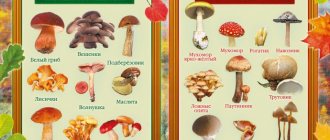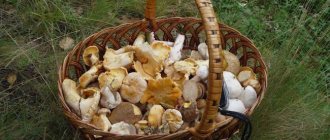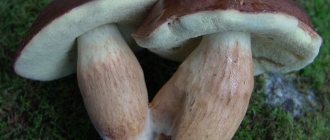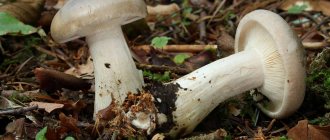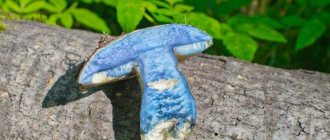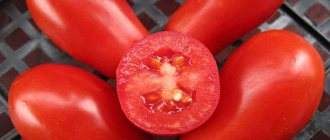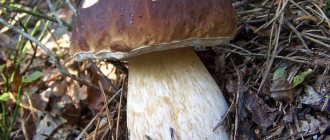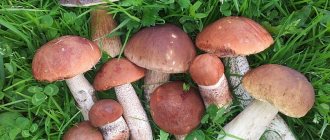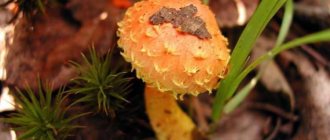Characteristic features of the variety
People have several names for this species, for example oiler or pepper fly. It got its name for its specific bitter taste.
Appearance and photo
The specimen in question belongs to the tubular mushrooms; it is brown in color. It has a convex cap and a cylindrical stem of small diameter. The pulp of the fruiting body is loose and brittle, yellow in color.
There is no pungent odor, but there is a bitter taste, and the flesh changes color when cut or pressed. The stem matches the color of the cap and does not have a ring, which will help in identifying this forest dweller.
Structure and species differences
Pepper oiler belongs to the Boletaceae family, class Anaricomycetes. The species has the following structural features:
- The mushroom cap is convex in shape and becomes flatter as it grows. Diameter - up to 8 cm. The color range ranges from light brown to copper, and can also acquire red and brown shades depending on the habitat. The surface is dry and velvety to the touch, but becomes slimy in rainy weather.
- The height of the leg reaches 4-8 cm, in diameter - 1.5 cm. The leg is cylindrical in shape, narrowed downward, often curved, smooth texture. The color is the same as that of the cap, but maybe a little lighter; at the bottom it has a yellow tint. There are no rings.
- The pulp is loose in structure and breaks easily, changing color to red when cut. The taste of the pulp is like hot pepper, but there is no distinct specific smell.
- The tubular layer is adherent, the same shade as the mushroom cap, pores of irregular angular shape. When pressed, it acquires a dirty brown tint.
Pepper oiler
This structure of the pepper mushroom makes it possible to distinguish it from other fellows in the forest by external signs.
Place of distribution
This type of oiler prefers a temperate climate zone. Its habitat is Europe, the Caucasus, the Urals, Siberia, and the island of Tasmania. The fungus forms mycorrhiza more often with deciduous trees, but sometimes with coniferous trees.
Places where the fungus spreads
It does not bear fruit in large quantities like other types of butterweed. You can meet it quite often in both mixed and coniferous and deciduous forests. Selects soil with small forbs. The ripening period is July-October.
Answers to common questions
Pepper mushroom grows in the temperate climate zone and can be found quite often in the forest; it has its own counterparts and distinctive features for identification. The taste fully corresponds to its name. There is no consensus on the edibility of this species.
Pepper mushroom
Scientific classificationKingdom:MushroomsDivision:BasidiomycetesClass:AgaricomycetesOrder:BoletalesFamily: BoletaceaeGenus:ChalciporusView:Pepper mushroomLatin nameChalciporus piperatus (Bull.) Bataille, 1908 Pepper mushroom, or
pepper butterdish
(lat. Chalcíporus piperátus) is a brown tubular mushroom from the Boletaceae family (lat. Boletaceae), in Russian-language literature it often belongs to the genus Maslyonok (lat. Suillus), and in modern English-language literature - to the genus
Chalciporus
.
Homotypic synonyms
[1]:
- Boletus piperatus Bull., 1790
- Viscipellis piperata (Bull.) Quél., 1886
- Leccinum piperatum (Bull.) Gray, 1821
- Suillus piperatus (Bull.) Poir., 1806
- Ixocomus piperatus (Bull.) Quél., 1888
- Ceriomyces piperatus (Bull.) Murrill, 1909
Edibility of the mushroom
There have been debates regarding the edibility of the flywheel for many years, and mycologists have not come to a consensus on whether it is edible or not. There are three options regarding the properties of the mushroom and assigning it to one of the classes:
- Edible – can be eaten after heat treatment. For its unusual taste, it is especially respected by some people who add it to their dishes to enhance the piquancy.
Pepper mushroom
- Conditionally edible - the Russian interpretation of practical mushroom pickers; when cooked, the fruiting body loses its bitterness. You can pickle, boil, fry and prepare seasoning powder.
- Inedible - the official domestic version due to the fact that even with processing, toxins from the oil dish do not completely leave and can accumulate in the body. Not recommended for use in any form.
The decision as to whether to eat it or not is left to individual discretion.
What taste does it have?
Experienced mushroom pickers recommend avoiding tasting the mushroom. At the same time, its taste qualities are noted:
- initially it tastes like champignon with a slight mushroom smell;
- when a sufficient amount of the mushroom enters the oral cavity, a burning sensation appears as if you put a pinch of ground pepper in your mouth;
- after the end of the burning effect, a bitter aftertaste appears, which is difficult to eliminate.
It is recommended to heat the mushroom for 15 minutes. It does not reduce the pungency of the mushroom, but it does reduce the bitterness.
In European countries, it is widely used in the preparation of various dishes and is even used as an independent seasoning.
Rules and meeting places
If you decide to collect pepper flyweed, you should look for it in the short grass of different forest areas. Usually they grow 3-4 pieces in one place; for symbiosis they choose deciduous trees such as birch, beech, and young pine trees.
You should adhere to the basic collection rules:
- Do not take old and wormy fruit bodies.
- Inspect the cap for the presence of insect remains on it.
- Avoid quiet hunting in industrial areas and near highways.
- Do not cut off specimens that are in doubt.
It is also important to remember that even edible species can become toxic if left untreated for a long time; it should not be delayed long after returning home from the forest.
When boletus grows
What time can you go into the forest and pick mushrooms? Naturally, everything depends on the climatic characteristics of the region where butternuts are collected. They begin to appear above ground in June, but if it is too cold and the average daily atmospheric temperature is below +16 degrees, then it is too early for mushrooms to grow.
Mushrooms begin to grow best when the summer weather is already warm and there are warm rains. At the same time, you can already pick mushrooms 7 hours after the rain has stopped.
Many mushroom pickers know that boletus is the most favorite mushroom of worms. However, if there is a wormy mushroom in the basket, you should not throw it away. It is best to hang it with its leg down on a branch. The fungus will gradually dry out and “scatter” spores, thereby forming a new mycelium. After some time, you can come to this place and collect a new crop.
Difference from similar edible and inedible mushrooms
The pepper mushroom has no poisonous counterparts, but it can be confused with some edible mushrooms.
First of all, it is similar to its fellow boletus, of which it belongs. If confused, pepper fly can significantly spoil the taste of canned food or other dishes due to its bitter taste. The main difference is the absence of a ring on the stalk and the red color of the spores, while in other species the spores are yellow and there is a characteristic ring on the stalk.
Butter
This species is often confused with another representative of the Boletaceae family, the Kozlyak. The shape and color of their caps are similar. Mushrooms can be distinguished from each other by the color of the tubular layer and the pulp. The goat fly always has a milky or dirty pink color of the spores, while the pepper fly has a brown and brown tint. The color of the flesh of the goat is white, while that of the pepper fly is yellow.
Goat mushroom
Bitterweed is another look-alike that can be mistaken for pepper buttermilk. It is similar to its counterpart in the color of the cap and stem, but also has characteristic distinctive features: pink flesh, gray-yellow tint of the tubular layer and a mild spicy taste. By these signs you can confidently recognize him while in the forest.
Bitter mushroom
Despite certain similarities, all these types of mushrooms can be distinguished by careful examination of their structure and structure.
Definitioner
Basidia (Basidia)
Lat. Basidia. A specialized structure of sexual reproduction in fungi, unique to basidiomycetes. Basidia are terminal (end) elements of hyphae of various shapes and sizes, on which spores develop exogenously (outside).
Basidia vary in structure and method of attachment to hyphae.
Based on the position relative to the axis of the hyphae to which they are attached, three types of basidia are distinguished:
Apical basidia are formed from the terminal cell of the hypha and are located parallel to its axis.
Pleurobasidia are formed from lateral processes and are located perpendicular to the axis of the hypha, which continues to grow and can form new processes with basidia.
Subbasidia are formed from a lateral process turned perpendicular to the hyphal axis, which stops growing after the formation of one basidium.
Based on morphology:
Holobasidia are single-celled basidia, not divided by septa (see Fig. A, D).
Phragmobasidia are divided by transverse or vertical septa, usually into four cells (see Fig. B, C).
By type of development:
The heterobasidium consists of two parts - the hypobasidium and the epibasidium developing from it, with septations (see Fig. C, B) or without them (see Fig. D).
Homobasidia is not divided into hypo- and epibasidia and in all cases is considered to be holobasidium (Fig. A).
The basidium is the site of karyogamy, meiosis, and the formation of basidiospores. Homobasidy, as a rule, is not functionally divided, and meiosis follows karyogamy. However, the basidia can be divided into probasidium, the site of karyogamy, and metabasidium, the site of meiosis. Probasidium is often a resting spore, for example in rust fungi. In such cases, the probasidium germinates into a metabasidium, in which meiosis occurs and on which basidiospores are formed (see Fig. E).
See Karyogamy, Meiosis, Hypha.
PileipellisLat. Pileipellis, skin - a differentiated surface layer of the cap of agaricoid basidiomycetes. The structure of the skin in most cases differs from the inner flesh of the cap and may have a different structure. The structural features of pileipellis are often used as diagnostic characters in descriptions of fungal species.
Based on their structure, they are divided into four main types: cutis, trichoderma, hymeniderma and epithelium.
See Agaricoid fungi, Basidiomycete, Cutis, Trichoderma, Hymeniderma, Epithelium.
Useful properties, medical use and restrictions on use
According to a number of studies, the mushroom contains a toxic substance that is not neutralized by heat treatment and is not removed from the body. It can cause cirrhosis and liver cancer.
Nevertheless, this species is used in folk medicine. The mushroom contains substances such as leucine and alanine, which help lower blood sugar levels and normalize weight. It is also rich in phytoncide, which is a natural antibiotic. The fruits contain protein, phosphorus, magnesium, selenium, and folic acid.
Pepper mushroom
Due to its chemical composition, pepper moss is used in medicine to make drugs that help cope with the following conditions:
- pressure stabilization;
- improving the functioning of the immune system;
- destruction of cholesterol;
- strengthening the nervous system;
- activation of brain activity.
Interesting!
In folk medicine, peppercorns are used to combat warts, papillomas, and treat burns.
Cooking full-fledged dishes from pepper butter is not practiced, but it is often used as an additive to other types or as a spicy note in the preparation of other products. Restrictions on the consumption of such food apply to children, pregnant women and people with chronic diseases.
Growing boletus at home
To grow boletus, select a site with young (10 to 15 years old) pines, cedars, larches or spruces. Butterflies prefer partial shade and acidic soils.
To develop mycelium, the top layer of soil is removed by 20 cm and a nutrient layer is formed. The first one is laid out from plant materials (cut grass, fallen leaves, chopped wood, pine needles). The second layer consists of soil, which is collected from where the mushrooms grow. Mycelium is sown on the prepared soil.
Mycelium is sown in spring. The substrate is evenly distributed over the area, then covered with a layer of leaves or grass and a layer of garden or forest soil. The sown area is watered using the drip method and moistened as it dries.
The first harvest is harvested a year after sowing, and fruiting continues for up to 15 years. In autumn, the area is covered with straw, grass, and leaves. In spring this protective layer is removed.
Seasoning recipe
Among amateur cooks and professional chefs, a seasoning made from dried pepper butter is popular. The process of making it is simple, it can be reproduced at home by following these instructions:
- clean and rinse the mushrooms thoroughly;
- break the stems and caps into pieces;
- cook for 1.5-2 hours, you can change the water during the process;
- drain the water and dry the butter in the oven for 3-4 hours;
- be sure to turn over during drying;
- grind into powder in any way;
- Place back into the oven for a few minutes.
Preparing mushrooms for cooking
The finished seasoning should be stored in a hermetically sealed container, preferably glass. This seasoning, when added to food, will have the pungency of pepper and a mushroom aroma at the same time.
How to assemble a grate correctly?
The summer months of July to August and early September are when kid production peaks. By October there are very few of them. It is advisable to choose young fruiting bodies and avoid old ones, as they accumulate harmful components. It is especially dangerous to pick fruiting bodies along highways and in industrial zones near operating enterprises. The goats absorb radioactive substances and exhaust gases.
When assembling a grate, you need to take only strong, intact specimens. Listen to their smell (it should be a pleasant mushroom smell), and avoid outwardly unfamiliar mushrooms - those with a strange hue. Kids, unfortunately, are kind of record holders for worms. Both caps and legs can be damaged. It is advisable to immediately cut off and throw away the wormy parts of the bogworms.
For beginner mushroom pickers, an overview of the “Kat Kids” mushrooms is provided in the video below:
Is it necessary to clean the oil from the film?
Cleaning the film is a prerequisite when preparing butter.
The feasibility of cleaning oil from the film:
- The film is not poisonous or harmful, but during the process of frying unpeeled mushrooms, the film sticks to the pan and the mushroom falls apart. This spoils its appearance. If you are preparing soups, the film will give the dish a jelly-like state and a fairly viscous consistency.
- If you do not want to spoil the soup, the film must be removed. Before freezing, it is necessary to remove this film; after using the frozen mushroom, it will resemble jelly, and in general such mushrooms become watery and bitter when cooked.
- We recommend cleaning the film before freezing, frying, or boiling. Indeed, it is quite difficult to clean, so it is recommended to leave the mushrooms for a while so that the cap dries out. Then the film is easily removed with a knife.
- There is another cleaning option - boil it for a few minutes in boiling water. This way the film can also be easily removed.
Cleaning oily
